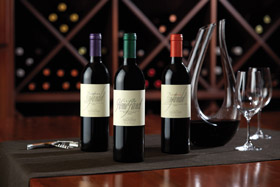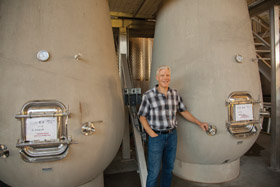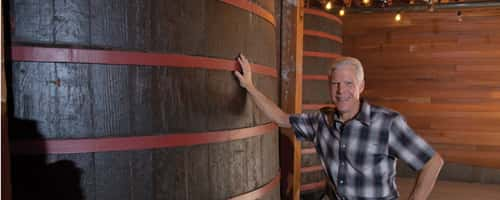
When Edoardo Seghesio left Italy in 1886, little did he know that he was on his way to building an American winemaking legacy. Seghesio left his family’s vineyards in the Piedmont region to join his best friend at an agricultural colony. The Italian Swiss Colony had been established in the far reaches of northern Sonoma County by fellow Italian Andrea Sbarboro. Sbarboro developed a profitable business focused mostly on grape production, and provided work for many Italian immigrants who were arriving in San Francisco.
Colony employees were housed and fed at the site but weren’t paid until they had worked there for three years. They had to sign on for two-year stints at a time, and Seghesio was no exception. His original intent was to work in America, then return home to marry his childhood sweetheart. Instead he met another Italian immigrant, Angela Vasconi, the colony manager’s niece, and they married in 1893.
Seghesio and his young bride searched the area they fell in love with, looking for property where they could begin realizing their dream of starting their own winery. In 1895, they bought a modest home set amongst 56 rambling acres of countryside spread between Geyserville and Cloverdale. The Alexander Valley tract was a fairly pricey piece of land for the times, but with the Russian River in close enough proximity to use for irrigation, the couple found it ideal. Seghisio started by planting his favorite varietals, Zinfandel, Sangiovese and other old world hearty reds. Today, some of those once tender young plants have been producing fruit for more than a century, resulting in some of Sonoma County’s finest old-vine Zinfandel wines.
The early days
 Seghesio continued to work at the Colony 10 hours a day, six days a week. He used his earnings to build the winery and to purchase more property. When he finished building Seghesio Family Vineyards in 1902, he resigned from the Colony and focused all of his attention on his own vineyards and the art of making wine. Angela handled the business end of their venture, and the household as their family grew to include five children. The winery prospered in California’s fledging wine industry until Prohibition began. Seghesio didn’t think the ban on alcohol would last long and decided to purchase the company he had worked for when he first arrived in America. Italian Swiss Colony was a winery with a four million gallon capacity and 1,100 acres of vineyards and the $127,000 pricetag was considered reasonable.
Seghesio continued to work at the Colony 10 hours a day, six days a week. He used his earnings to build the winery and to purchase more property. When he finished building Seghesio Family Vineyards in 1902, he resigned from the Colony and focused all of his attention on his own vineyards and the art of making wine. Angela handled the business end of their venture, and the household as their family grew to include five children. The winery prospered in California’s fledging wine industry until Prohibition began. Seghesio didn’t think the ban on alcohol would last long and decided to purchase the company he had worked for when he first arrived in America. Italian Swiss Colony was a winery with a four million gallon capacity and 1,100 acres of vineyards and the $127,000 pricetag was considered reasonable.
Unfortunately, Prohibition lasted longer than Seghesio expected and he couldn’t manage the debt without being able to sell the wine, thus not generating any revenues. He brought his son-in-law into the venture, Enrico Prati, along with the Rossi Family, and eventually sold his shares so he could focus on his own winery. Very few wineries survived the 14 year long ban on liquor. Of the 2,000 plus wineries that existed at Prohibition’s start, Seghesio was only one out of 100 wineries that survived.
“Prohibition was one of the greatest challenges the winery and the family had to endure,” says Ted Seghesio, great grandson of Edoardo and Angela, and general manager and winemaker for Seghesio Family Vineyards. “A lot of wine was poured into the creeks. The industry was decimated and didn’t recover until the big planting boom in the early 1970s,” says Ted. The family’s most difficult years bonded them closely together and more than a few stories from that period have passed from one generation to the next. “Eat bread, was one of the sayings my great grandfather was known to repeat because bread was inexpensive, and to make a living during lean times, he knew how to be frugal,” says Ted.
 There were a few loopholes during Prohibition and one was that each household could produce up to 200 gallons of wine for their own use. The Seghesios shipped grapes by rail to those wanting to make their own wine and it helped to provide some income in the early years, but 14 years of Prohibition eventually took its toll. Law abiding wine families questioned whether to break the law to help their businesses survive and preserve way of life, hard earned in the new country. It wasn’t unusual to hear about gun battles that took place on dark wine country roads, and how local law enforcement sometimes secretly sided with winery families, trying to keep them out of the hands of the Federal Prohibition agents that attempted to set up stings and “get them” every chance they could.
There were a few loopholes during Prohibition and one was that each household could produce up to 200 gallons of wine for their own use. The Seghesios shipped grapes by rail to those wanting to make their own wine and it helped to provide some income in the early years, but 14 years of Prohibition eventually took its toll. Law abiding wine families questioned whether to break the law to help their businesses survive and preserve way of life, hard earned in the new country. It wasn’t unusual to hear about gun battles that took place on dark wine country roads, and how local law enforcement sometimes secretly sided with winery families, trying to keep them out of the hands of the Federal Prohibition agents that attempted to set up stings and “get them” every chance they could.
“When the 18th Amendment was passed, prohibiting the production and transport of alcohol, the new law didn’t prohibit the consumption of alcohol. It even allowed households to produce 200 gallons annually. The whole situation seemingly encouraged bootlegging. There are accounts indicating that some bootlegging was going on,” says Ted without confirming whether the Seghesio’s took part in the unlawfulness of the times. “The whole situation seemingly encouraged it.” The family lore is documented in Vivienne Sosnowski’s book, When the Rivers Ran Red: An Amazing Story of Courage and Triumph in America’s Wine Country. According to the book, late one night, on a road being tracked by Federal Prohibition agents, a driver with a large load of wine was stopped and brought to the Seghesio homestead where it was thought the shipment originated. “Ultimately, it was said that the agents tried to bribe us, but eventually the truth revealed that it was the other way around, and the agents got caught,” says Ted. Around three o’clock in the morning the agents said they saw a truck heavily loaded with wine, pass by their lookout point. They followed the truck and stopped it, but couldn’t get the driver to talk. The agents decided to follow the truck’s tracks, tracing them back to the Seghesio Ranch Homestead.
Arriving at the home, they found two men—Edoardo and his son, Arthur—sitting at the table eating bread. The driver of the truck said something to them in Italian, a language the agents didn’t understand, and when the agents asked about the wine in the truck, the men denied selling it to the driver. Angela came into the room and found Edoardo handcuffed to the young truck driver and started to cry. She asked, “What is the trouble?” Edoardo called his son-in-law to bring over the winery records to prove his innocence. When Prati arrived, one of the agents alleged that they were offered a $5,000 bribe to release the truck driver and said that they’d increase it to $10,000 if they’d allow for future shipments of wine to pass from Asti to San Francisco. It’s said that the next morning, after Prati handed off the money to the agents, that he reported what happened to his family and U.S. Intelligence officials were alerted. In the end, two agents fled and one was sentenced to Leavenworth Penitentiary. After more investigation the Seghesio family name was finally cleared and in good standing after it was determined the money had been an attempt at extorting the family.
Stewards of the land
 How does a family business survive so many challenges? “Having a strong connection to the land and to family is part of what has enabled us to make it in this business. We’re making wine from the same grape vines that my great grandfather made wine from, treasures that we call old vine Zinfandel. We craft pretty exceptional wine that we pass onto consumers,” says the fourth generation winemaker.
How does a family business survive so many challenges? “Having a strong connection to the land and to family is part of what has enabled us to make it in this business. We’re making wine from the same grape vines that my great grandfather made wine from, treasures that we call old vine Zinfandel. We craft pretty exceptional wine that we pass onto consumers,” says the fourth generation winemaker.
From the late 1950s to the 1970s the Seghesios found great success in the bulk wine business. They produced most of the red wine made in Sonoma County and at their peak, they produced 1.7 million gallons between the original winery in Chianti and the Healdsburg winery. Though they were always focused on Zinfandel, the varietal fell out of favor in the 1970s. Then a new wine trend started in the 1980s when the consumption of white Zinfandel became popular. Seghesio capitalized on the fad since the wine was made from Zinfandel grapes that had to be picked earlier to produce the pale pink wine variation.
The second and third generations of Seghesios continued to run the family business until the early 1980s when the addition of the fourth generation stepped in and took control of farming, production, sales, winemaking and distribution. “We were the first to borrow money from the bank. The family had never done that before but there was agreement that it was an investment in the future,” says Ted.
In 1983, the younger generation opened up a whole new avenue of winemaking when they shifted production from bulk wine to higher quality wine going for quality over quantity. “There were a dozen or so family members employed in the business and we all shared the same goals. The strength of our family was the group dynamic. We all wanted to grow the business based on the quality of the wine. Sharing a common goal helped us grow together,” says Ted.
Some family members who worked for the winery before it was sold to the Crimson Wine Group in 2011, left subsequent to the sale, but Ted, with sky blue eyes reminiscent of his family’s northern Italian lineage, is not the only Seghesio to be found still working for the winery. His brother-in-law, Jim Neumiller, is in charge of Vineyard management along with Ted’s fifth generation nephew, Ned Neumiller, who oversees Grower Relations and Vineyard management. Both Neumillers worked side-by-side with the third generation’s Peter Seghesio, who learned viticulture from the family.
“There’s a belief that the first thing that goes out the window when a wine group takes over is quality, but that has not been the case here. The Crimson Wine Group has given us the tools to become wildly efficient,” says the fourth generation Seghesio. With the Crimson Wine Group’s emphasis on quality, focus and growth, it’s not surprising that the Seghesio family approved of the improvements that have happened since the sale. Some of the enhancements include a new fermentation hall that was completed in 2015, and the purchase of concrete fermenting eggs from Sonoma Cast Stone and concrete tanks from Nico Velo of Italy. And in 2014, we purchased the 24-acre Montafi Vineyard, known for century-old Zinfandel vines in the Russian River Valley. Crimson’s portfolio contains nine luxury wine brands, and Seghesio fits nicely into their portfolio, with their wines having garnered a spot on Wine Spectator’s prestigious Top 100 list six times in the last decade.
Modern-day challenges
 Though the hardships of Prohibition are long gone, it doesn’t mean it’s always smooth sailing for those in the wine business. Last year proved to be a taxing one for many wineries, especially when it came to sourcing people to harvest the grapes. Five months before harvest, Seghesio held a big town meeting with their groweto talk about how to bring enough hands to the area to make sure the grapes would be picked at the right time. Since Seghesio Family Vineyards has been utilizing the H2A visa program since 2008, staff shared information with other growers about how to utilize workers who possess the temporary work visas that are issued to foreign agricultural workers with a job offer for seasonal agricultural work in the U.S.
Though the hardships of Prohibition are long gone, it doesn’t mean it’s always smooth sailing for those in the wine business. Last year proved to be a taxing one for many wineries, especially when it came to sourcing people to harvest the grapes. Five months before harvest, Seghesio held a big town meeting with their groweto talk about how to bring enough hands to the area to make sure the grapes would be picked at the right time. Since Seghesio Family Vineyards has been utilizing the H2A visa program since 2008, staff shared information with other growers about how to utilize workers who possess the temporary work visas that are issued to foreign agricultural workers with a job offer for seasonal agricultural work in the U.S.
Seghesio Family Vineyards staff has traveled to Mexico and to the U.S.-Mexican border to recruit skilled vineyard workers. They have helped the workers acquire the temporary work visas and then safely, and legally, transported them to Sonoma County to live and work on their properties for nine months. Ever since Edoardo’s time, farm superintendents were given lodging on-site. Because the cost of living in Sonoma County is so expensive, the winery built The Hacienda on their Home Ranch to affordably house seasonal workers who wanted to live on their property.
Employing H2A visa holders means that the vineyards are fully staffed all the way through harvest. Without readily available labor, the wineries risk having no workers available when their grapes are at the optimal time to be harvested, often only a two- to three-day window, even less if the weather was extremely hot as it was in 2017. Local wineries also had to fight vine stress in 2017, a condition caused by the record-breaking heat. “Drip irrigation is a great tool to control vine stress,” says Ted. Without drip irrigation, the 2017 grape crop easily could have been lost. Though heat wasn’t the only problem the winery faced in 2017. Excessive rain after years of drought, also added to the winery’s grape growing difficulties. Then came the devastating wildfires that decimated many of Napa and Sonoma counties vineyards. “We had finished our harvest except for one lot at a vineyard that was one mile from the fires,” says Ted. The hurricane-force winds at the time of the fires, pushed smoke into this lot, causing the grapes to suffer smoke damage but much worse was that five employees lost their homes.
Manmade trials and natural disasters may have slowed the winery’s progress, but today the winery continues to thrive. The family vineyards in the Alexander, Dry Creek and Russian River Valleys, which total more than 350 acres, contain some vines that have been tethered to the Earth for over a century. Today the winery produces incredible wines that are made almost exclusively from estate-owned and sustainably farmed vineyards. Edoardo and Angela were the first stewards of the land and the current generation believes they would be proud of the way the winery utilizes the greenest inputs possible to sustainably foster the long-term health of the vineyards and the high quality of the grapes they produce. They are constantly looking at new ways to conserve resources, especially around water and energy use. As the next generation develops an interest in a wine-driven career, they’re encouraged to get experience outside of the family venture so that they can bring new ideas and knowledge back to the fold.




